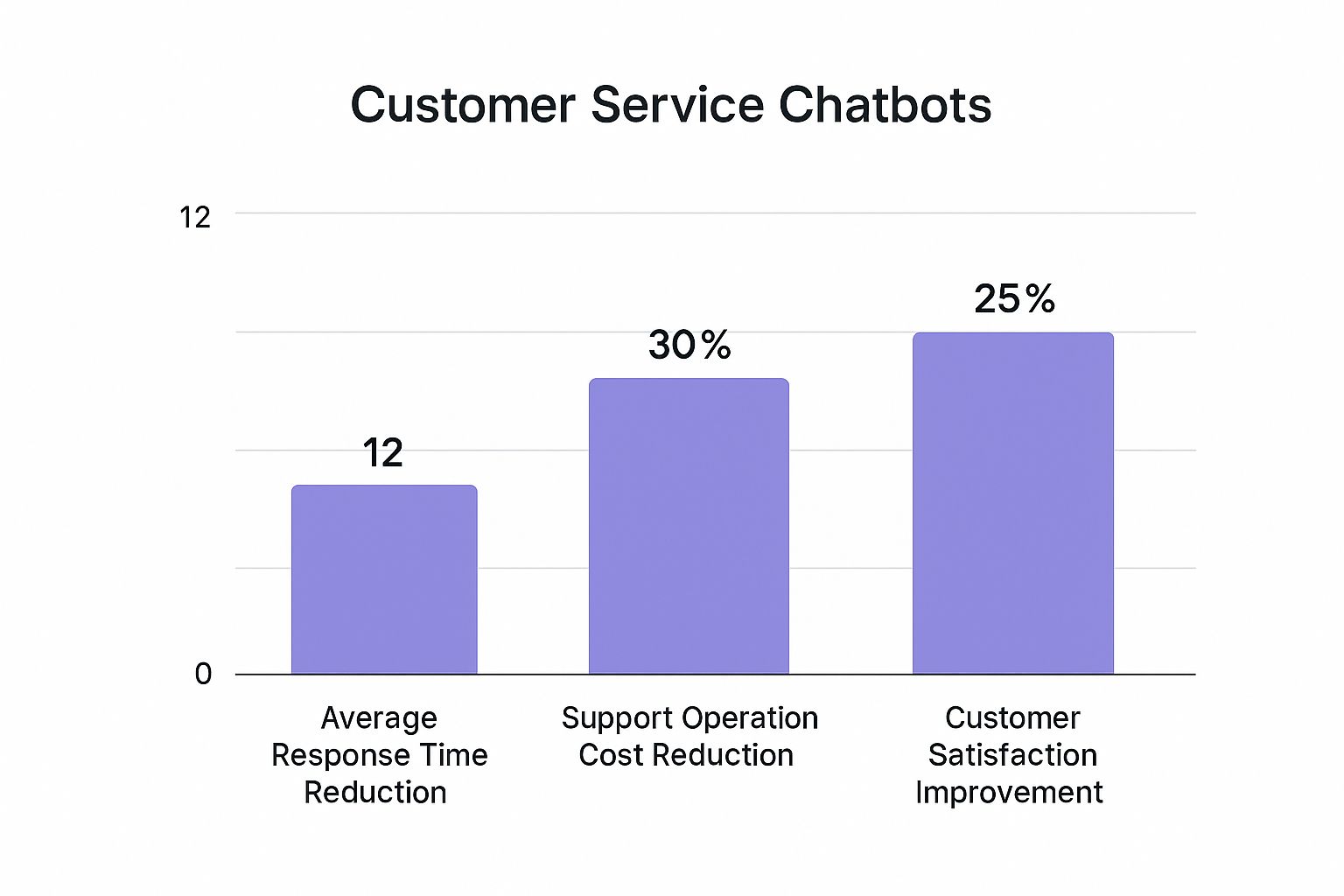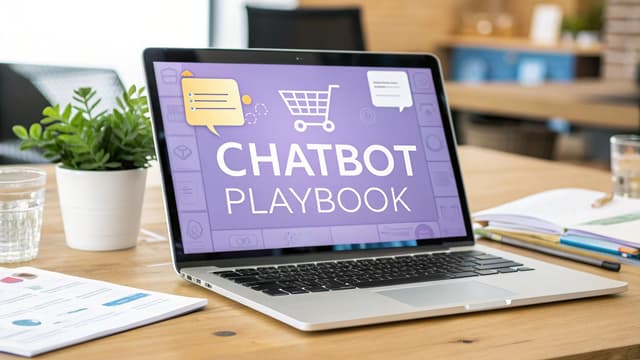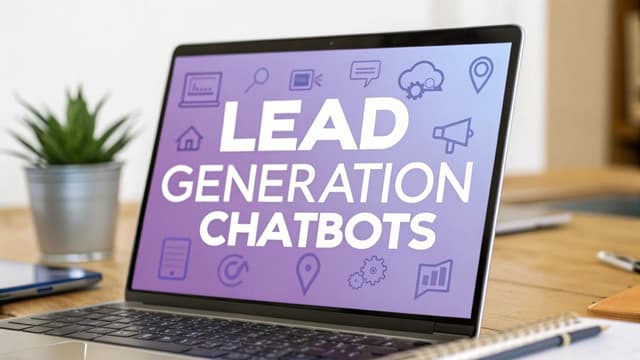Unlocking the Potential of Chatbots: A Deep Dive into Real-World Applications
This listicle reveals seven powerful chatbot use cases. We'll go beyond simple descriptions, providing strategic analysis and actionable insights for practical application. Discover how chatbots can transform your business, from automating customer service to driving sales. We'll analyze real-world examples, extracting key takeaways you can implement immediately. Learn how to optimize chatbot functionalities, boost efficiency, and enhance customer satisfaction. This deep dive into chatbot use cases provides a roadmap for success in various sectors.
Explore these key areas:
- Strategic chatbot implementation: Learn why specific chatbot strategies worked (and why some didn't).
- Tactical insights: Uncover specific chatbot tactics to replicate in your own business.
- Actionable takeaways: Gain practical steps to implement chatbot solutions effectively.
This listicle will cover these chatbot applications:
- Customer Service and Support Chatbots
- E-commerce and Sales Chatbots
- Healthcare Virtual Assistants
- HR and Recruitment Chatbots
- Lead Generation and Marketing Chatbots
- Educational and Training Chatbots
- Banking and Financial Services Chatbots
Ready to explore the transformative power of chatbots? Let's dive in.
1. Customer Service and Support Chatbots
Customer service and support chatbots are AI-powered conversational interfaces designed to handle customer inquiries, troubleshoot issues, and provide instant support 24/7. These chatbots leverage natural language processing (NLP) to understand customer requests and respond appropriately, mimicking human conversation. They can resolve common problems, guide customers through self-service options, and escalate complex issues to human agents when necessary, ensuring a seamless customer experience. This automation significantly reduces response times and operational costs, freeing up human agents to focus on more complex issues. This makes them a powerful tool in any business's chatbot use cases arsenal.
Examples of Successful Implementations
Several companies have successfully implemented customer service chatbots, demonstrating their effectiveness in various industries. Bank of America's virtual assistant, Erica, helps customers with basic banking tasks, such as balance inquiries and bill payments. H&M uses a chatbot to guide customers through frequently asked questions about orders and returns, streamlining the support process. Sephora's beauty assistant offers personalized product recommendations and beauty tips, enhancing customer engagement. These examples showcase the versatility and adaptability of customer service chatbots across different business needs.
Actionable Tips for Implementation
- Implement clear escalation paths to human agents: Ensure a smooth transition from chatbot to human support for complex or sensitive issues.
- Regularly update the knowledge base: Keep the chatbot's information current to provide accurate and relevant responses.
- Use natural language processing (NLP) for better understanding: Enable the chatbot to comprehend nuances in customer language for more effective communication.
- Monitor customer satisfaction metrics: Track key metrics like resolution time and customer feedback to continuously improve chatbot performance.
- Provide easy opt-out options: Allow customers to easily connect with a human agent if they prefer.
When and Why to Use Customer Support Chatbots
Customer service chatbots are invaluable for businesses seeking to provide scalable, 24/7 customer support. They are particularly beneficial for:
- Handling high volumes of repetitive inquiries: Automating responses to common questions frees up human agents.
- Providing instant support outside of business hours: Offer continuous assistance, improving customer satisfaction.
- Reducing customer service costs: Streamlining support operations lowers operational expenses.
- Gathering customer data and insights: Chatbot interactions provide valuable data on customer behavior and preferences.
The following infographic illustrates the potential impact of customer service chatbots on key performance indicators. The chart compares the average reduction in response time, support operation cost reduction, and customer satisfaction improvement achieved through chatbot implementation.

As the data reveals, businesses implementing customer service chatbots experience significant improvements across all three metrics. The chart demonstrates a substantial decrease in response times, along with notable reductions in support costs and improvements in customer satisfaction. Learn more about Customer Service and Support Chatbots here. Companies like Zendesk, Intercom, LiveChat, Drift, and the Microsoft Bot Framework offer robust platforms for building and deploying effective chatbot solutions. By strategically implementing these tools and following best practices, businesses can transform their customer service operations and achieve significant improvements in efficiency and customer satisfaction.
2. E-commerce and Sales Chatbots
E-commerce and sales chatbots are specialized conversational agents designed to guide customers through the purchasing journey. These bots act as virtual sales assistants, providing personalized shopping experiences and increasing conversion rates. They leverage AI and natural language processing (NLP) to understand customer preferences, browsing history, and purchase behavior to make relevant product suggestions, answer questions, and even process orders. This personalized approach enhances customer engagement and streamlines the buying process, leading to increased sales and customer satisfaction.

Examples of Successful Implementations
Several brands have successfully integrated e-commerce chatbots into their sales strategies. Domino's pizza ordering bot allows customers to seamlessly order their favorite pizzas through a conversational interface. 1-800-Flowers uses a chatbot as a gift advisor, helping customers choose the perfect bouquet based on occasion and recipient preferences. Tommy Hilfiger's TMY.GRL provides personalized styling advice and product recommendations. These examples demonstrate how e-commerce chatbots can be tailored to specific industry needs and customer preferences. Chatbots are essential for customer support, and you can read more about how to effectively automate customer service.
Actionable Tips for Implementation
- Focus on user intent recognition: Accurately interpret customer needs and provide relevant assistance.
- Implement smart product filtering: Guide customers to the right products quickly and efficiently.
- Use visual elements for product showcasing: Enhance product presentations with images and videos.
- Create urgency with limited-time offers: Encourage immediate purchases with exclusive deals.
- Track and optimize conversion funnels: Monitor chatbot performance and identify areas for improvement.
When and Why to Use E-commerce and Sales Chatbots
E-commerce chatbots are particularly effective for businesses looking to enhance their online sales channels. They are beneficial for:
- Providing 24/7 sales support: Offer continuous assistance and address customer queries around the clock.
- Personalizing the shopping experience: Deliver tailored product recommendations and enhance customer engagement.
- Automating order processing: Streamline the checkout process and reduce manual tasks.
- Increasing conversion rates: Guide customers toward purchasing decisions with personalized guidance.
- Gathering customer data and insights: Track customer interactions to identify preferences and trends.
Platforms like Shopify, WooCommerce, Magento, Facebook Messenger, and WhatsApp Business have embraced chatbot integration, demonstrating the growing importance of conversational commerce. Learn more about E-commerce and Sales Chatbots. By leveraging these platforms and implementing the strategies outlined above, businesses can transform their online sales operations and create more engaging and personalized shopping experiences for their customers.
3. Healthcare Virtual Assistants
Healthcare virtual assistants are specialized chatbots designed to provide patients with convenient and accessible healthcare information and support. These AI-powered tools use natural language processing (NLP) to understand patient inquiries and offer relevant responses, streamlining various healthcare interactions. They can handle tasks like scheduling appointments, conducting preliminary symptom assessments, providing medication reminders, and answering frequently asked questions about medical conditions. This automation improves patient engagement while freeing up healthcare professionals to focus on more complex cases. This makes them a valuable addition to the evolving landscape of chatbot use cases.

Examples of Successful Implementations
Babylon Health's AI doctor provides personalized health assessments and advice, allowing patients to access primary care services remotely. Ada Health's symptom checker helps users understand potential causes for their symptoms and recommends appropriate actions. Buoy Health's assistant guides patients through a series of questions to determine the best course of action for their health concerns. Florence, a medication reminder bot, sends timely notifications to ensure patients adhere to their prescribed medication schedules. These examples demonstrate the versatility of healthcare virtual assistants in addressing various patient needs.
Actionable Tips for Implementation
- Ensure HIPAA compliance: Prioritize patient data privacy and security by adhering to all relevant healthcare regulations.
- Include clear medical disclaimers: Inform patients that the chatbot's advice should not replace professional medical consultations.
- Integrate with existing healthcare systems: Connect the chatbot with electronic health records (EHRs) for seamless data exchange.
- Provide easy access to human healthcare providers: Offer clear pathways for patients to connect with doctors or nurses when necessary.
- Regular updates with latest medical guidelines: Keep the chatbot's information current to ensure accurate and reliable health advice.
When and Why to Use Healthcare Virtual Assistants
Healthcare virtual assistants are ideal for healthcare providers seeking to improve patient access and engagement. They are particularly beneficial for:
- Providing 24/7 access to health information: Patients can access support and guidance at any time, regardless of clinic hours.
- Streamlining appointment scheduling: Automate the booking process, reducing administrative burdens and wait times.
- Improving medication adherence: Timely reminders help patients stay on track with their medications, promoting better health outcomes.
- Conducting preliminary symptom checks: Guide patients through self-assessment before connecting them with healthcare professionals.
- Reducing the workload on healthcare staff: Automating routine tasks allows healthcare providers to focus on complex patient cases.
Healthcare virtual assistants enhance patient experiences and optimize healthcare operations. By adhering to best practices and prioritizing patient privacy, healthcare providers can leverage these tools to deliver efficient, accessible, and high-quality care. Companies like Microsoft and IBM offer platforms for building and deploying healthcare chatbot solutions. This allows businesses to customize their virtual assistants to meet their specific needs.
4. HR and Recruitment Chatbots
HR and recruitment chatbots are AI-powered tools designed to streamline HR processes, from answering employee queries to managing complex recruitment workflows. These chatbots leverage natural language processing (NLP) to understand and respond to employee and candidate requests, effectively mimicking human conversation. They can automate tasks like screening candidates, scheduling interviews, providing company information, and handling routine HR inquiries. This automation frees up HR professionals to focus on more strategic initiatives, like talent development and employee engagement. This makes them a valuable asset in optimizing HR operations and improving overall efficiency.
Examples of Successful Implementations
Several organizations have successfully integrated HR chatbots into their workflows. Unilever's recruitment bot significantly reduced screening time and improved candidate experience. L'Oreal's chatbot, Mya, automates candidate communication and interview scheduling, increasing efficiency. Even McDonald's uses a hiring assistant to pre-screen applicants and provide information about job openings, demonstrating the versatility of this technology. IBM's HR chatbot answers employee queries regarding company policies and benefits, streamlining internal communications. Vodafone's TOBi for HR handles a range of employee requests, further highlighting the diverse applications of HR chatbots.
Actionable Tips for Implementation
- Train chatbots on company-specific policies: Ensure accurate and relevant responses to employee inquiries.
- Ensure bias-free screening processes: Implement safeguards to prevent discriminatory practices during candidate screening.
- Maintain human oversight for final decisions: While chatbots automate many tasks, human judgment remains crucial in critical HR decisions.
- Regularly update with policy changes: Keep the chatbot's knowledge base current to reflect the latest company policies.
- Provide escalation paths for complex issues: Enable seamless transition to human HR professionals for sensitive or complex matters.
When and Why to Use HR and Recruitment Chatbots
HR chatbots offer significant benefits for businesses looking to improve HR efficiency and employee experience. They are especially beneficial for:
- Streamlining recruitment processes: Automating tasks like screening and scheduling saves time and resources.
- Providing 24/7 support to employees: Offer immediate assistance to employee questions, regardless of time or location.
- Reducing HR workload: Automating repetitive tasks frees up HR staff to focus on strategic initiatives.
- Improving onboarding experience: Guide new hires through the onboarding process and provide essential information.
- Gathering employee feedback: Use chatbots to collect valuable insights on employee satisfaction and engagement. The evolving role of technology in industries like healthcare is also apparent. Explore the expanding role of AI medical staff in transforming healthcare delivery; for instance, they are already changing how healthcare is delivered. This trend, like HR chatbots, highlights the growing importance of AI in optimizing various sectors.
Companies like Workday, BambooHR, Cornerstone OnDemand, IBM Watson Talent, and Microsoft Teams HR bots offer platforms for building and deploying effective chatbot solutions for HR. By implementing these tools strategically and adhering to best practices, businesses can transform their HR operations and unlock greater efficiency, improve employee satisfaction, and drive better business outcomes. This makes HR and recruitment chatbots a compelling chatbot use case for organizations of all sizes.
5. Lead Generation and Marketing Chatbots
Lead generation and marketing chatbots are AI-powered conversational tools designed to capture leads, qualify prospects, and nurture potential customers. These bots engage website visitors, collect contact information, segment audiences, and guide prospects through marketing funnels, all while providing personalized content and offers. They act as virtual sales assistants, working 24/7 to engage prospects and move them closer to conversion. This automation empowers marketing teams to scale their outreach and personalize customer interactions, resulting in higher conversion rates and improved marketing ROI.
Examples of Successful Implementations
Several companies have successfully implemented marketing chatbots to drive lead generation and enhance customer engagement. HubSpot uses chatbots to qualify leads and book meetings with sales representatives, automating the initial stages of the sales process. Drift leverages conversational marketing chatbots to engage website visitors, answer questions, and capture lead information in real time. Intercom utilizes lead generation bots to segment website visitors based on their behavior and offer tailored product recommendations. These diverse applications demonstrate the power of chatbots in driving marketing results.
Actionable Tips for Implementation
- Time bot triggers strategically: Trigger chatbot interactions based on user behavior, such as time spent on a page or specific actions taken.
- Use progressive profiling for lead data: Collect lead information gradually over multiple interactions to avoid overwhelming visitors.
- Integrate with CRM systems: Seamlessly transfer lead data to your CRM for efficient follow-up and nurturing.
- Test different conversation flows: Experiment with different chatbot scripts and conversational paths to optimize conversion rates.
- Offer valuable content as lead magnets: Provide ebooks, white papers, or exclusive content in exchange for contact information.
When and Why to Use Lead Generation and Marketing Chatbots
Lead generation and marketing chatbots are ideal for businesses seeking to automate lead capture and personalize marketing interactions. For HR and recruitment chatbots, explore strategies that transform hiring. See this helpful resource: chatbot in recruitment. These bots are particularly beneficial for:
- Capturing leads 24/7: Engage website visitors and collect contact information even outside of business hours.
- Qualifying prospects based on pre-defined criteria: Filter leads based on demographics, behavior, and interests.
- Nurturing leads with personalized content and offers: Deliver targeted messages to move prospects through the sales funnel.
- Automating marketing campaigns: Schedule automated chatbot sequences to deliver promotional content and offers.
- Scaling marketing outreach: Reach a larger audience with personalized messages without increasing staff.
Learn more about Lead Generation and Marketing Chatbots. Companies like HubSpot, Drift, Intercom, ManyChat, and Chatfuel offer robust platforms for building and deploying effective marketing chatbot solutions. By strategically implementing these tools and adhering to best practices, businesses can enhance their marketing efforts, generate more qualified leads, and drive significant business growth.
6. Educational and Training Chatbots
Educational and training chatbots are AI-powered conversational agents designed to enhance learning experiences. These chatbots act as personalized tutors, providing on-demand support, delivering course content, and tracking student progress. They leverage natural language processing (NLP) to understand student inquiries and respond with relevant information, creating interactive and engaging learning environments. This personalized approach allows educational chatbots to adapt to different learning styles and pace, making education more accessible and effective. This makes them a powerful addition to any institution's toolkit, enriching chatbot use cases in education.
Examples of Successful Implementations
Several institutions have successfully integrated educational chatbots into their learning programs. Duolingo uses a chatbot to facilitate language learning through interactive exercises and personalized feedback. Georgia State University's Pounce chatbot assists students with administrative tasks, like enrollment and financial aid inquiries. Coursera employs chatbots to deliver course materials and answer student questions, enhancing the online learning experience. These examples demonstrate the versatility of educational chatbots in supporting diverse learning needs and administrative processes.
Actionable Tips for Implementation
- Align with curriculum standards: Ensure the chatbot content aligns with established educational goals and learning objectives.
- Include multimedia learning materials: Incorporate diverse content formats, like videos and interactive quizzes, to engage learners.
- Track learning analytics: Monitor student progress and identify areas where additional support may be needed.
- Provide multiple explanation methods: Offer different ways of explaining concepts to cater to diverse learning styles.
- Enable peer-to-peer learning: Facilitate online discussions and collaborative learning opportunities through the chatbot.
When and Why to Use Educational and Training Chatbots
Educational and training chatbots are invaluable for institutions seeking to personalize and enhance learning. They are particularly beneficial for:
- Providing 24/7 learning support: Offer on-demand assistance and answer student questions anytime, anywhere.
- Delivering personalized learning experiences: Tailor learning paths and content based on individual student needs and progress.
- Automating administrative tasks: Streamline processes like enrollment and course registration.
- Tracking and analyzing learning data: Gather insights into student performance to improve teaching methods and curriculum design.
- Scaling educational resources: Reach a wider audience and offer consistent learning support regardless of location.
Educational and training chatbots represent a significant advancement in educational technology. By leveraging the power of AI and conversational interfaces, these chatbots can personalize learning, improve accessibility, and enhance the overall educational experience for students of all levels. Companies like Microsoft, IBM, and Google offer platforms and resources for developing and deploying educational chatbot solutions. By adopting these technologies and implementing best practices, educational institutions can transform their teaching and learning processes, fostering a more engaging and effective learning environment for students.
7. Banking and Financial Services Chatbots
Banking and financial services chatbots are transforming how customers interact with their finances. These AI-powered virtual assistants provide 24/7 support, handling tasks from balance inquiries and transaction history to loan applications and investment guidance. Built with robust security measures, these chatbots ensure compliance with strict financial regulations while offering personalized financial advice and streamlined banking services. They represent a crucial evolution in chatbot use cases within the financial sector.
Examples of Successful Implementations
Several leading financial institutions have successfully deployed chatbots to enhance customer experience and operational efficiency. Bank of America's Erica allows customers to check balances, pay bills, and even receive proactive financial guidance. JPMorgan Chase's digital assistant helps customers with everyday banking tasks and fraud alerts. Capital One's Eno provides transaction notifications and assists with credit card management. These examples demonstrate the diverse applications of chatbots in addressing various banking needs.
Actionable Tips for Implementation
- Implement multi-factor authentication: Prioritize security by employing robust authentication methods to protect sensitive financial data.
- Ensure PCI DSS compliance: Adhere to Payment Card Industry Data Security Standard (PCI DSS) regulations for secure transaction processing.
- Provide clear transaction confirmations: Offer detailed confirmations for all financial transactions to maintain transparency and build trust.
- Offer financial education content: Empower customers with educational resources on budgeting, saving, and investing through the chatbot interface.
- Maintain audit trails: Keep comprehensive records of all chatbot interactions for compliance and security purposes.
When and Why to Use Banking and Financial Services Chatbots
Banking and financial services chatbots are invaluable for institutions looking to provide seamless, personalized banking experiences. They are particularly beneficial for:
- Handling high volumes of routine inquiries: Automating responses to common questions like balance checks and transaction history frees up human agents.
- Providing 24/7 customer support: Offer continuous assistance, enhancing customer satisfaction and accessibility.
- Streamlining loan applications and other processes: Guide customers through complex financial processes, simplifying the user experience.
- Offering personalized financial advice: Provide tailored recommendations based on customer financial data and goals.
- Enhancing security and fraud detection: Implement real-time monitoring and alerts to prevent fraudulent activities.
Companies like Kore.ai, Personetics, and Finn AI offer specialized platforms for developing and deploying AI-powered chatbots tailored to the banking and financial services industry. By strategically implementing these tools and following best practices, financial institutions can enhance customer engagement, improve operational efficiency, and strengthen security measures in today's rapidly evolving digital landscape.
Chatbot Use Cases Comparison Matrix
| Chatbot Type | Implementation Complexity 🔄 | Resource Requirements ⚡ | Expected Outcomes 📊 | Ideal Use Cases 💡 | Key Advantages ⭐ |
|---|---|---|---|---|---|
| Customer Service and Support | Moderate - requires NLP and CRM integration | Medium - ongoing training and updates | Faster response times, cost reduction, customer satisfaction | Customer support in banking, retail, telecom | 24/7 availability, scalable, consistent quality |
| E-commerce and Sales | Moderate to High - integration with inventory, payments | Medium-High - multiple system integrations | Increased conversion rates, reduced cart abandonment | Online retail, product recommendation | Personalized shopping, upselling, cart recovery |
| Healthcare Virtual Assistants | High - strict regulatory compliance and data privacy | High - compliance, medical updates | Improved patient access, reduced admin burden, early detection | Healthcare providers, patient support | 24/7 health support, cost-effective, HIPAA compliant |
| HR and Recruitment | Moderate - integration with HR systems | Medium - policy training and bias mitigation | Faster hiring, improved candidate experience | Recruitment, onboarding, employee queries | Time-to-hire reduction, consistent info delivery |
| Lead Generation and Marketing | Moderate - CRM integration and conversation flows | Medium - regular optimization and A/B testing | Higher lead conversion, automated qualification | Marketing campaigns, lead capture | Personalized engagement, cost-effective lead gen |
| Educational and Training | Moderate - personalized learning and content creation | Medium - significant educational content | Personalized learning, engagement, scalable support | E-learning, training, student support | 24/7 support, interactive learning, consistent delivery |
| Banking and Financial Services | High - strong security, regulatory compliance | High - secure data handling and compliance | Instant financial info, cost reduction, literacy | Banking transactions, financial advice | Enhanced security, 24/7 service, compliance focus |
Strategically Implementing Chatbots for Maximum Impact
This exploration of chatbot use cases reveals a powerful tool for businesses across diverse sectors, from e-commerce and customer service to healthcare and HR. The key takeaway is that strategic implementation is crucial for maximizing impact. This isn't just about deploying a chatbot; it's about understanding its potential and aligning it with your specific business goals.
Key Takeaways for Successful Chatbot Implementation
Several core principles emerged from our analysis of these diverse chatbot use cases. Let's recap the most crucial takeaways:
- User-Centric Design: Prioritize understanding your target audience. What are their needs, preferences, and pain points? Design conversational flows that address these directly, creating a seamless and intuitive user experience.
- Seamless Integration: Integrate your chatbot seamlessly with existing systems. This includes CRM platforms, order management systems, and internal databases. This allows for personalized interactions and efficient data flow.
- Continuous Optimization: Monitor, analyze, and optimize your chatbot's performance. Regularly review conversation logs, gather user feedback, and adjust the chatbot's responses and flows accordingly. This iterative process is essential for continuous improvement.
- Strategic Alignment: Define clear objectives for your chatbot. How will it contribute to your overall business strategy? Whether it's lead generation, customer support, or process automation, ensure your chatbot's function aligns with your goals.
Why Mastering Chatbot Strategy Matters
Mastering these concepts allows you to leverage chatbots effectively. This goes beyond simply automating tasks. It's about creating engaging experiences, enhancing customer satisfaction, and streamlining operations for increased efficiency.
Actionable Next Steps
To capitalize on these insights, consider the following next steps:
- Identify key areas: Pinpoint areas within your business where a chatbot can provide the most value. This could be customer service, sales, or internal processes.
- Define specific goals: Set measurable goals for your chatbot implementation. This will help you track progress and demonstrate ROI.
- Choose the right platform: Select a chatbot platform that aligns with your technical capabilities and business requirements.
By adopting these strategies, you can harness the full potential of chatbots. They become more than just automated tools; they become valuable assets that drive business growth and provide a competitive edge. The future of customer interaction is evolving, and strategically implemented chatbots are at the forefront of this transformation.
Ready to transform your business with AI-powered chatbots? FlowGent AI offers a powerful platform to deploy and manage sophisticated chatbot strategies across various channels. Visit FlowGent AI to explore how FlowGent AI can help you leverage the full potential of chatbot use cases and propel your business forward.


